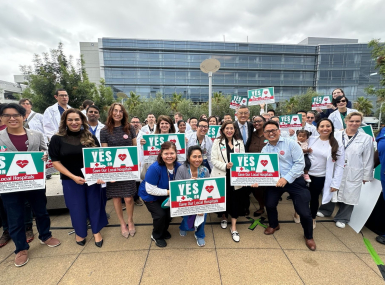The Evolution of Medicaid and Why It Matters to Counties
Upcoming Events
Related News
On July 30, 1965 at a ceremony in Independence, Mo., President Lyndon B. Johnson signed into law what would become the nation’s primary health insurance coverage for low-income populations and the top health priority for counties across the country.
Public Law 89-67, which established Medicaid (alongside Medicare) and became Title XIX (19) of the Social Security Act, came about as America’s health system was undergoing rapid changes. Fifty years later, America’s health system continues to evolve along with the Medicaid program.
Americans were first widely introduced to health insurance coverage during the World War II years when manufacturers — unable to raise wages due to wartime economic controls — started adding health benefits to attract employees. Meantime, the nation’s health system was in disarray as thousands of health professionals, discharged from their wartime service, began re-entering the medical field.
A New Legislative Presentation
In conjunction with the 50th Anniversary of Medicaid, NACo has released a new legislative presentation titled “Medicaid and Counties: Understanding the Program and Why It Matters to Counties.” The presentation explains Medicaid basics and details the county role in both funding and delivering Medicaid, with specific county examples. It also explains why Medicaid is a target for cuts in the 114th Congress, who the key players are, and provides key messages that county officials can use in their advocacy efforts to protect the federal-state-local partnership for Medicaid. Visit http://www.naco.org/featured/medicaid-and-counties
Seeing an opportunity, President Harry Truman first asked Congress to adopt a comprehensive health program for the nation in 1946 but was not able to gain support. The issue would be pushed off the table until the early 1960s as more and more workers gained employer-sponsored health insurance, and gaps in coverage significantly widened for older adults, the disabled and the poor.
President John F. Kennedy brought these issues to the forefront, but it would only be after his untimely death that his successor President Johnson could gain enough support for what would become the Medicaid and Medicare programs.
Medicaid was originally intended to provide health insurance for low-income children deprived of parental support, their caretaker relatives, the elderly, individuals with disabilities and the blind.
The program now provides health and long-term care insurance to more than 70 million low-income Americans including pregnant women, children and parents, people with disabilities, poor seniors who are also covered by Medicare, and, in states that have opted to expand Medicaid under the Affordable Care Act, low-income childless adults previously ineligible for the program.
Over the last 50 years, Congress and the states have expanded and reformed Medicaid to better cover the uninsured and underinsured. A voluntary program in which all states and the District of Columbia now participate, Medicaid provides vital federal matching funds to counties as they care for low-income populations and strive to meet the current and future health needs of all of their residents.
Commissioner Mary Ann Borgeson, chair of NACo’s Health Steering Committee, says: “Douglas County (Neb.) ensures delivery of Medicaid-eligible services to our residents through the dozens of world-class health care facilities that we are fortunate enough to have spread throughout our community.
“In addition to these excellent providers, our own five-star rated Douglas County Health Center continues to be a leader in our community for long-term care and rehabilitation services,” she said. “Our county also manages the Community Mental Health Center, which continues to make a significant impact on the mental health challenges facing our community.”
The Medicaid program helps counties satisfy their obligations to their residents in both urban areas such as Douglas County as well as in rural communities. It reduces the frequency of uncompensated care provided to local hospitals and health centers, lessening the strain on county budgets. It creates increased access to health care services, which in turn improves residents’ health, productivity and quality of life. Medicaid provides patient revenue that helps communities retain doctors and other health professionals, especially in rural and underserved areas.
Nearly one-third of rural physicians receive at least 25 percent of patient revenues through Medicaid reimbursements.
Unlike Medicare, which is solely funded by the federal government, Medicaid is funded by federal, state — and in many instances — local governments. The federal government’s share of Medicaid expenditures, is formula-based and in FY12, the federal share of total national Medicaid spending was about 57 percent.
States have a significant amount of flexibility in determining which sources of funds to use to finance the nonfederal share of Medicaid. Local governments such as counties may contribute up to 60 percent of the nonfederal share of Medicaid and at least 16 states require counties to contribute to the nonfederal share. In New York, for instance, counties are mandated to contribute and send nearly $140 million per week to the state for Medicaid costs. In FY12, counties nationwide financed the majority of the approximately $28 billion in local government contributions of Medicaid.
As the historic safety-net health systems in their communities and both providers and funders of Medicaid, counties have a vested interest in protecting the Medicaid program as it continues to evolve over the next 50 years.
Attachments
Related News

CMS issues new guidance on Medicaid Community Engagement Requirements
On December 8, the Centers for Medicare & Medicaid Services (CMS) released a Medicaid and CHIP Services Informational Bulletin (CIB) directing states on how to implement the Medicaid community engagement requirements enacted under Section 71119 of the One Big Beautiful Bill Act legislation (Public Law 119-21), or H.R. 1.

California county sales tax measure backfills federal healthcare cuts
Santa Clara County, Calif. will raise an estimated $330 million each year from a sales tax to backfill lose Medicaid funding.
